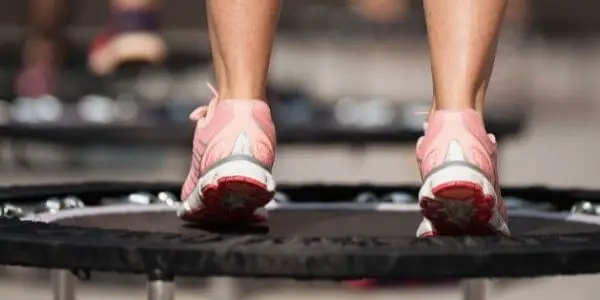Rebounding is currently highly in vogue after those famous NASA studies made headlines a few years ago. Besides, everybody who’s anybody is happily rebounding, from Madonna to Gwyneth Paltrow and Jennifer Gardner.
But is it that good, or is it all just marketing?
We’ll unravel the science behind rebounding in the article below, taking you through the most relevant studies. First, we’ll analyze the benefits, the risks, and then we’ll reach our conclusions.
Keep reading below.
Table of Contents
Trampoline Benefits
Let’s start with the ten advantages we promised in the title:
1. Fun Weight Loss
One of the main benefits of trampoline jumping is that you can lose weight while doing something fun. Many people give up working out because it’s too hard.
So, for example, you can start exercising, but working out is the first thing you cross out of your schedule when life gets too hectic. That’s mainly because working out doesn’t bring enough satisfaction.
That’s why it’s essential to stay fit by doing something you love, at least until you get used to working out daily.
2. Detoxification And Cleansing

The lymphatic system helps your circulatory system by decreasing any extra swelling in the body. This swelling is usually caused by stress, an accumulation of toxins, or excess proteins.
Here’s the catch:
The circulatory system relies on the heart as a pump that gets the blood moving. The lymphatic system doesn’t have this sort of corresponding pump – it depends on your body’s movements.
A trampoline workout benefits your lymphatic system in two ways:
- Firstly, any exercise increases lymphatic flow 10-30 times, so rebounding is a fun way to do that.
- Secondly, rebounding means subjecting your body to all sorts of gravitational force intensities, which act as a pump.
As a result, your lymphatic system will flow better to increase detoxification.
3. Better Mood
Rebounding is fun; it makes you feel like a kid. Besides, working out promotes the secretion of all sorts of happiness hormones, like endorphins and serotonin.
After working out, you’ll feel accomplished – so your brain will secrete dopamine, the reward hormone. If you see some results, you’ll get a more considerable dopamine influx. All these happiness hormones decrease stress.
Low-stress levels plus better detoxification lead to an improved immune system. That means better chances to fight common illnesses like the flu, and some even say reduced aging process.
Here’s the thinking:
Cell oxidation leads to a world of problems, like “ugly” aging, chronic illness, and problems sleeping. Conversely, a better immune system can fight cell oxidation caused by free radicals better.
So a mini trampoline benefits your long-term health because it strengthens your immune system.
4. Better Looking Skin

Wrinkles, acne, and cellulite are common skin problems.
However, one of the health benefits of rebounding is improving your immune system. The other is toning your muscles.
This combination of advantages will improve the look of your skin because:
- Your body flushes toxins faster
- You’re losing weight, aka fat weight
- Your muscles are more toned, so they produce more collagen. And if you didn’t know this, collagen is what makes your skin supple and wrinkle-free
5. Increased Bone Density
Weight-bearing exercise increases bone density so that you can have stronger bones. And that’s precisely what rebounding is: a type of weight-bearing exercise.
But why should you choose to jump on the trampoline instead of running or strength training?
One reason is that rebounding is more fun than running on the treadmill and doing mindless reps in the gym.
Most importantly, though, rebounding is a lower impact. That sounds pretty counterintuitive, but studies show the forces acting on your back, ankles, and forehead are below the standard threshold of rupture for an average person.
Basically, rebounding exercise benefits your bones because it’s both effective and safe.
6. Weight Loss Without Stressing Your Heart And Lungs
The NASA study we cited in the section above has some other interesting conclusions:
- Jumping on the trampoline demands less oxygen intake even when you’re working hard.
- The ratio of oxygen consumption is twice as efficient as running on the trampoline
Here’s what all that means:
You can burn more calories with less stress on your heart and lungs. That means you can protect your heart even when you’re working hard to get fit or lose excess weight.
It’s important to know this because often, unfit people want to lose weight quickly by putting too much pressure on their hearts and lungs. Sure, exercising generally improves your cardiovascular health and lung capacity, but not if you’re overexerting yourself.
Trampoline workout benefits sedentary people or people with preexisting heart issues because it’s effective. So your heart and lungs will work less, but you will get fit.
7. Toned Muscles

Rebounding is a total body exercise that tones all your muscles.
It’s obvious why jumping up and down would tone your quads, calves, hamstrings, and glutes. But this sort of exercise also increases your core strength because you’ll have to squeeze your core to keep your balance.
Pro tip: Do specific exercises to target your core and upper body muscles while rebounding. For example, leg lifts, squats, and lunges on the trampoline challenge your abs and lower back more.
Warning: If you use hand weights to tone your arms and shoulders while rebounding, pick small weights. Jumping with heavy weights can lead to injuries, so that’s never a good idea.
8. More Endurance
Exercise will generally increase your endurance as you’re getting your heart and lungs used to a specific pattern of oxygen consumption. Besides, it strengthens your bones and tones your muscles, so basically, you have the proper support for building stamina.
Advice: If you want to increase your endurance, work according to your heart rate. Do exercises that give you a good challenge without hurting.
9. Increased Balance

Jumping on the trampoline increases your balance because you’ll have stronger muscles, stronger bones, and more core strength. As such, you’ll be altogether fitter and more flexible without damaging your joints.
That’s arguably one of the essential benefits of rebounding for seniors: surpassing your functional limitations in a safe, fun way.
Sure, jumping on the trampoline can seem ridiculous to you if you’re in your golden years, but remember that’s just an unfounded bias. Who said only kids could have fun?
10. Reduced Fatigue
Reduced fatigue is another primary advantage for seniors because chronic tiredness is widespread past a certain age. However, the stressful lives that most of us are living today also lead to chronic fatigue in younger people.
Jumping on the trampoline can help with this problem because:
- You’re in a better mood
- Your body flushes out more toxins
These two features reduce stress, which is the number one enemy of your healthy endocrine system. And a healthy level of hormones means:
- You’ll be getting enough sleep at night because you won’t have to deal with insomnia.
- You won’t experience as much brain fog or headaches that leave you feeling weak and weary.
Rebounding Disadvantages/Negative Side Effects

After going through some of the essential health benefits of trampoline jumping, let’s see what the science says about the negative side effects of rebounding:
- You could get injured. To avoid this, don’t place your mini-trampoline near the walls. If you’re using the trampoline inside, make sure you don’t jump high enough to hit the ceiling with your head. And, if you’re not sure whether you can hold your balance on the trampoline, choose one with handlebars.
- You could aggravate preexisting health issues. For example, if you have sciatica, pinched nerves, or scoliosis, ask your doctor before jumping on the trampoline. Rebounding will compress and decompress your spine in all sorts of weird ways, which can increase your pain or even make your condition worse.
- It’s maybe not best for pregnant people. Again, though, consult your OB. Factors like your fitness level, age, pregnancy issues, and placenta locations will influence your ability to use the trampoline. Besides, a difficult birth or pregnancy can lead to organ prolapse and incontinence. If that’s your case, ask your OB whether rebounding is safe for you.
- Jumping too long on the trampoline will lead to injuries. Although rebounding is safer for your joints than running on the treadmill, excess exercise weakens your bones instead of strengthening them.
We went into more detail about possible side effects in this article.
In Conclusion
Jumping on the trampoline helps get you stronger and leaner. You will develop endurance, cleanse your body from toxins, and improve your mood. As a result, you’ll look, feel, and sleep better.
Rebounding benefits everyone, including the elderly. If you’re in this age group, short 20-minute sessions each day can improve your balance and bone density in a few weeks.
Besides, rebounding is generally safe because it’s low impact and doesn’t stress your heart and lungs. The only risks associated with trampoline jumping are accidental or caused by preexisting conditions. That’s why you should always double-check with your doctor or physical therapist to get the best mini trampoline for your needs.
- 7 Exercises for Pregnant Women in the First Trimester: Safe and Effective - January 30, 2025
- Our equipment recommendations - October 30, 2024
- Here’s What Doing Cardio Every Day Does To Your Body - August 21, 2024

